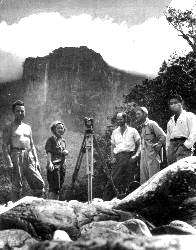Aleksandrs Laime
Aleksandrs Laime[1] (Spanish: Alejandro Laime, English: Alexander Laime) was a famous Latvian-born explorer. He is most noted for being the first recorded human to reach Angel Falls, located in Venezuela, by foot. He also established, together with Charles Baughan, the tourist camp of Canaima, created solely for the purpose of bringing tourists to Angel Falls.[2]
Aleksandrs Laime | |
|---|---|
 Laime (far left) with Ruth Robertson's expedition of 1949 | |
| Born | July 9, 1911 |
| Died | March 21, 1994 |
Early life
Aleksandrs Laime was born in July 9, 1911 in Riga. He grew up in Grīziņkalns neighborhood and since early childhood was interested in adventure stories and shipping. In age of 15 he learned basic principles of sailing in Ķīšezers. Together with some friends they stole a sailboat and traveled to Liepāja. They planned to sail across the Baltic sea to Sweden but due to storm they were washed ashore on the Estonian island of Saaremaa. In age of 16 Laime went to Paris from where he traveled by foot through the France. In Marseilles he boarded merchant ship and traveled to Egypt where he lived in Cairo for several months until his parents sent him money for journey back home.[3]
After return to Riga Laime studied in Riga Technical school and graduated as land surveyor. In 1936 Laime together with friend took a sailing trip to Danzig. There they changed their sailboat for kayaks and traveled through Poland. They wanted to reach the Black Sea but were discouraged from such move by Romanian border guards. His friend went back home but Laime sat on the bicycle and traveled to Paris.
In 1939 Laime started a sailing trip from Riga to Africa but due to start of World War II he was stopped in Kiel. However he managed to reach Africa via the United Kingdom and Spain. He traveled across the western coast of Africa until he reached Cape town. There Laime boarded a merchant ship and traveled to coasts of United States and Canada. In 1940 he landed in Caracas and settled in Venezuela
Activity in Venezuela
After moving to Venezuela in 1940, Laime led many explorations through the jungles of south Venezuela. First years in Venezuela Laime worked as a topographer in a road construction department later he also worked in oil company Socony and Ingenerie de Orinoko. In 1942 Laime for the first time visited Canaima and settled there. Together with Charles Baughan and some other European partners they started to develop tourism in Canaima. They built an airfield and houses for visitors in Canaima. In 1949 he was part of Ruth Robertson's team which reached Angel Falls by ground and surveyed the falls.[2] He reached the summit of Auyantepui in 1955, and along with his native companion Manuel Fiorentino were the first to reach Jimmie Angel's crashed plane "Flamingo."[4] He explored the surface of the tepuy, and named unnamed rivers there. He gave the river on which Angel Falls is the name Gauja, after the a Latvian river of the same name.[4] It is sometimes written as Rio Gauya. He also named three other rivers, Rio Venta, Rio Daugava and Rio Ogre, all after celebrated rivers of Latvia. He was married to Vilma Laime who died in April 2009 at her residence in Huntingdon Valley, Pennsylvania, U.S.A. and is survived by his son Alexander Laime, stepdaughter Ilse Wood, grandchildren Robert Wood, Jr. and Sandra Jones, and great grandchildren, Rachel Wood, Carissa Wood, Zackary Wood, and Richard Jones all of whom reside in the Pennsylvania and New Jersey areas, U.S.A.
Search for the "Golden River"
After hearing news of Jimmie Angel's famed "Golden River", Laime, like many of his contemporaries, went in search of the river. He has never publicized if he actually found it, but close friends say he really had found it. After Laime's death in 1994, approximately 20 000 dollars were found in a tin can, underneath Laime's fireplace in his house on Isla Orquidea (an island on the Rio Carrao, 2 hours upstream from Canaima).
Death
Laime came down the Churun River on March 20, 1994, to stockpile food and supplies for the next few weeks, as he usually did. He spoke to the wife of Ramon Jimenez, asking for him. He complained to her about chest pains, and said that he knew the end was near. He is reported as saying that he wanted to climb the great tepuy (Auyantepui) one last time, to die up there. He then went to the nearby Waku Lodge, for a drink. He died shortly thereafter in the bathroom of a heart attack.
References
- LAIME, ALEKSANDRS. "ALEKSANDRS LAIME". VOLAR. Retrieved 30 December 2019.
- Maddicks, Russell (2011). Venezuela: The Bradt Travel Guide. London: Bradt Travel Guides. p. 438. ISBN 9781841622996.
- Pētersone, Līva. "Kas bija Aleksandrs Laime". Diena. Retrieved 16 November 2011.
- KHATRI, VIKAS (2012). Greatest Wonders Of The World. V&S Publishers. p. 128. ISBN 9789350572474.
- Stavro, Andris., "Aleksandrs Laime un viņa zelta upe" (Apgāds Jāņa Sēta, Rīga, 1999, ISBN 9984-07-184-7)
- Personal account of Maria Jimenez, March 13, 2008